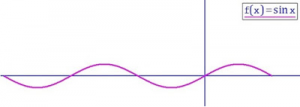i. If, f, g ate two continuous functions at a point a of their common domain D, then f ± g. fg are continuous at a point, then f/g is also continuous at a. ii. If f is continuous at a and f(a) ≠ 0, then there exists an open interval (a – δ, a + δ) such that for all x ϵ (a – δ, a + δ), f(x) has the same sign as f(a).
ii. If f is continuous at a and f(a) ≠ 0, then there exists an open interval (a – δ, a + δ) such that for all x ϵ (a – δ, a + δ), f(x) has the same sign as f(a).
iii. If a function f is continuous on a closed interval [a, b], then it is bounded on [a, b] i.e. there exist real numbers K and K such that K ≤ f(x) ≤ K for all x ϵ [a, b].
iv. If f is a continuous function defied on [a, b] such that f(a) and f(b) are of opposite signs, then there exists at least one solution of the equation f(x) = 0 in the open interval (a, b).
v. If f is continuous on [a, b], then f assumes at least once, every value between minimum and maximum values of f(x), then there exist at least solution of the equation f(x) = K in open interval (a, b).
vi. If f is continuous on [a, b] and maps [a, b] into [a, b], then for some x ϵ [a, b] we have f(x) = x.
vii. If g is continuous at a and f is continuous at g(a). The fog is continuous at a.
Evaluate: show that the function \(f\left( x \right)=\left\{ \begin{align} & x\sin \frac{1}{x},x\ne 0 \\ & 0\,\,\,\,\,\,\,\,\,\,\,\,\,,\,x=0 \\\end{align} \right.\) is continuous at x = 0
Solution: we have,
(LHL at x = 0)
= \(\underset{x\to {{0}^{-}}}{\mathop{\lim }}\,\)f(x)
= \(\underset{h\to 0}{\mathop{\lim }}\,\)f(0 – h)
= \(\underset{h\to 0}{\mathop{\lim }}\,\)f(- h)
= \(\underset{h\to 0}{\mathop{\lim }}\,\)– h sin (1/-h)
= \(\underset{h\to 0}{\mathop{\lim }}\,\)h sin (1/h)
= 0 x (An oscillating number between – 1 and 1)
= 0
(RHL at x = 0)
= \(\underset{x\to {{0}^{+}}}{\mathop{\lim }}\,\)f(x)
= \(\underset{h\to 0}{\mathop{\lim }}\,\)f(0 + h)
= \(\underset{h\to 0}{\mathop{\lim }}\,\)f(h)
= \(\underset{h\to 0}{\mathop{\lim }}\,\)h sin (1/h)
= 0 x (An oscillating number between – 1 and 1)
= 0
And,
f(0) = 0.
Thus, \(\underset{x\to {{0}^{-}}}{\mathop{\lim }}\,f\left( x \right)=\underset{x\to {{0}^{+}}}{\mathop{\lim }}\,f\left( x \right)=f\left( 0 \right)\).
Hence, f(x) is continuous at x = 0.
